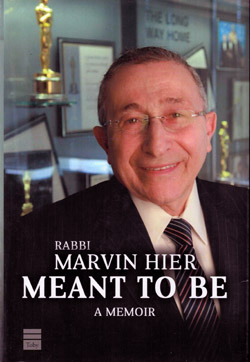Meant To Be by Rabbi Marvin Hier; Toby Press, LLC; © 2015; ISBN 978-1-59264-389-9; 342 pages including photo sections and index; $29.95
By Donald H. Harrison

 SAN DIEGO –This memoir tells the story of the founding of the Yeshiva University of Los Angeles, the Simon Wiesenthal Center, Moriah Pictures, and the Museums of Tolerance in Los Angeles and Jerusalem.
SAN DIEGO –This memoir tells the story of the founding of the Yeshiva University of Los Angeles, the Simon Wiesenthal Center, Moriah Pictures, and the Museums of Tolerance in Los Angeles and Jerusalem.
Hier, the entrepreneurial rabbi who set the course and raised the funds for all these multimillion dollar projects, grew up on New York’s Lower East Side, became a yeshiva bocher, and was sent to Vancouver, British Columbia, where he became an assistant rabbi and later the senior rabbi at Congregation Schara Tzedek. There he and his wife Malkie became used to Hier not only leading a congregation but also serving as a spokesman for the Jewish community and interacting with government officials and celebrities, including Queen Elizabeth of Great Britain.
After thirteen years in Vancouver, the rabbi and Malkie took their sons Avi and Ari for a three-month visit to Israel, during which Hier surfaced a question that he had been mulling for some time. Where will the boys go to yeshiva? There was none in Vancouver. Should he start one himself? And if so, where? Perhaps Los Angeles? With the two boys at his side, he asked the question of the Gerrer Rebbe, who advised him in Yiddish to “go immediately; you will have great success.”
The rebbe’s prediction proved right. With the help of Canadian philanthropists, who introduced him to their American counterparts, he located a building in the Pico-Robertson neighborhood of Los Angeles and never looked back. First came the yeshiva, but that was only the beginning of an experience, still ongoing, that would result in Hier becoming friends with heads of state and Hollywood celebrities.
There are numerous anecdotes in this memoir about the important people who helped Hier build an institution that not only documents and retells the story of the Holocaust but which also teaches the dangers of hatred, intolerance, racism, and bigotry, no matter where on Planet Earth they occur.
When he conceived the idea of the Simon Wiesenthal Center, Hier had not yet met Wiesenthal, and it was with considerable nervousness that he presented the idea to the famous hunter of Nazis. But the two men came to trust each other, and Wiesenthal’s reputation and Hier’s energy were crucial factors in the institution’s success and later expansion.
Among the visitors to the Museum of Tolerance was King Hussein of Jordan, who was visibly moved by the Holocaust exhibits. The King, aware that Hier could get in touch with Israel’s Prime Minister Benjamin Netanyahu, asked him to serve as a back channel to his Middle Eastern neighbor, with whom relations had become rocky. The king asked Hier to relay a message that if Netanyahu would be willing, on a return trip from the United States to Israel, he could stop over in London where he and the king could have a private meeting at Hussein’s residence in London. Hier accepted his assignment, Netanyahu was willing, and the meeting came off as Hussein had hoped.
Hollywood celebrities populate the pages of this book—including Marlon Brando, Jane Fonda, and Tom Cruise, to name just a few. There also are moments of soaring idealism in the book when the vow and prayer of “Never Again” and “Never Forget” touch readers’ hearts.
In the process of creating some important institutions serving not only his fellow Jews, but all people, Hier has led a remarkable life. His memoir is well worth reading.
*
Harrison is editor of San Diego Jewish World. He may be contacted via donald.harrison@sdjewishworld.com Comments intended for publication in the space below must be accompanied by the letter writer’s first and last name and by his/ her city and state of residence (city and country for those outside the U.S.)